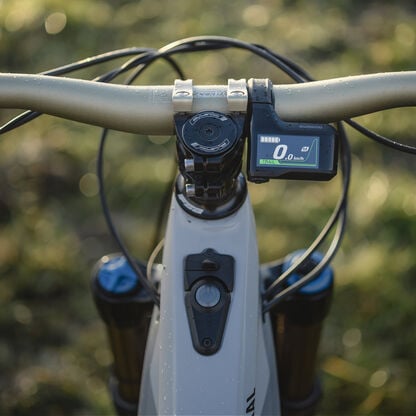Electronic or mechanical shifting system? What you need to know
Professionals swear by the electronic shifting system for their bike – but has the mechanical system served its time? We’ll explain when shifting gears electronically pays off and who’s better off shifting gears mechanically.


It doesn’t matter whether there’s an electronic or mechanical shifting system on the bicycle – both variants have their advantages and disadvantages. We will give you an overview of the most important application criteria and explain which type of bicycle is best suited to which type of shifting.
Contents
Introduction to electronic and mechanical shifting systems
Let’s take a look at how it works – what is the difference between “mechanical” and “electrical”? The mechanical shifting system consists of the rear derailleur, front derailleur, shift lever and Bowden cables. When the shift lever is operated, the Bowden cables are activated. These are thin wires that are usually hidden in the frame. Connect the shift lever to the front and rear derailleurs. The front derailleur ensures that the front chain is lifted onto the corresponding chainring. The rear derailleur puts the chain on a different sprocket.
In the case of electronic shifting systems, such as the Shimano Ultegra Di2-series, a motor will change gears instead of the Bowden cables. At the push of a button, it moves the rear derailleur and front derailleur either via a cable or wirelessly, like the SRAM Rival eTAP AXS.
Advantages and disadvantages of mechanical shifting systems
Benefits of mechanical shifting system:
Robust and fast repair: The mechanical shifting system rarely needs repair. If so, it is easy to find and fix the error. Any bike shop in the world can help you. The setup is simple – an advantage when you’re screwed.
Lightweight and affordable: It has little weight and is inexpensive. Rear derailleurs start at 10 Euros – of course it opens up at the top end of the scale.
Not reliant on power: Unlike electronic systems, mechanical shifting systems do not require a battery and therefore function at all times – regardless of the power supply.
Disadvantages of mechanical shifting system:
Wear even with good maintenance: The Bowden cable must be adjusted at regular intervals in order for the best possible traction performance. And no matter how well you maintain it, you’ll have to replace it one day because it stretches and the shifting system becomes less precise. This is noticeable when the chain rattles over the sprockets when shifting gears or hangs between two gears.
Force expenditure: In the sprint or on the mountain, it can be strenuous to shift up to the right gear.
Switching bandwidth limits: The mechanical shifting system design allows for a limited number of gears between the highest and lowest gears.

Advantages and disadvantages of electronic shifting system
Benefits of electronic shifting system:
Low force expenditure: All you have to do is press a button to shift gears. The shifting can also be adjusted to allow you to shift through multiple gears with the button held down for longer.
Safe, gentle and precise: Electronic shifting systems are very precise. There is no Bowden cable that could hook the chain or cause the shifting system to jerk. This will always change gear at the same speed and very gently. You also have a higher switching bandwidth.
No wear, easy maintenance: If there is no cable, there is also less wear. Components require less maintenance and no readjustment.
Good off-road: The electronic shifting system works better on mud and dirt and is therefore particularly suitable for cyclocross.
Chic wireless bike: Especially if you choose shifting systems that operate wirelessly, you will benefit from a more aesthetic look, without any cables.
For real bike nerds: The electronic shifting system is individually customizable to your needs. You can change the function of the levers, install additional control buttons or track more data on the driving mode. It is also possible to combine the shifting system with other components such as a GPS tracker.
Disadvantages of electronic shifting system:
Heavy caliber: If the bicycle shifting system is electronic, it adds an average of 300 to 400 grams – up to one kilo in extreme cases. If you are looking for as little weight as possible, this is an exclusion criterion.
Don’t forget to charge: If you forget to charge the battery, shifting gears is no longer possible and the tour can be very frustrating. One flaw is that you often don’t see the charge level directly on the shifting system, but only in the app. By the way: SRAM and Campagnolo shifting systems have batteries that you can remove for charging purposes. Shimano models require a nearby power outlet because the battery is fixed tight.
Repair effort and shock susceptibility: Unfortunately, electronic gear shifting systems are not particularly robust. If you ride with a high risk of falling, you risk damaging the expensive shifting system. If you break the shifting system on holiday, there is another problem: Fixing and troubleshooting is time consuming, spare parts are not always easy to come by.
High costs for shifting systems: Individual components are already worth 400 euros – entire groupsets are up to 3500 euros. Those who want to save money also have to take on more weight.
Compatibility and assembly: Assembly is often complicated, so it is best to consult a specialist company. If you want to connect your shifting system to other components, it is recommended to check compatibility beforehand.

Bicycle types and their shifting system options: Electronic or mechanical?
Which shifting system you choose also depends on which type of bike you ride. Offroad cycling or are you cruising?
Racing bike: Moving Electronically Fast
In the road cycling scene, electronic shifting systems are on the rise, and the number of manufacturers that install them is increasing. Price-conscious riders still rely on mechanical road bike groupsets – but more so on older bikes.
In principle, the electronic shifting system is the true gem in the road bike crown, because shifting precision and the low effort expenditure required can contribute to a significantly better performance on the asphalt. However, riders looking to save every gram will not be happy with the electronic shifting system.
Mountain bike: Shifting gear correctly on uneven terrain
With a MTB, you’ll not only be on unsteady ground, but sometimes in really bad weather conditions too. This is where the electronic shifting system has proved it’s worth because it also switches with precision when riding in mud and dirt. Furthermore less effort is required for switching gear up the mountain.
However, mechanical shifting can be a better choice for MTB, especially if you’re prone to a more wilder riding style. Impacts and falls are simply bad news for electronic shifting systems because they are quickly damaged.
Gravel bike: The best off-road shifting system
Even for gravel bikes, the electronic shifting system is sometimes the better choice. If you’re on the road a lot, the effort required to switch gears can certainly be depleted. The electronic shifting system really takes the load off the gravel bike, especially when the changing terrain necessitates many gear changes. The disadvantage: The more you shift gears, the shorter the battery life.
City bike: Cost-effective through the city
If you use a city bike in everyday life, mechanical shifting is a more cost-effective alternative to electronic shifting. The latter also makes your bike more attractive to thieves. Even when you want to leave your bike in the city, of course connected, you should choose the classic one.
E-bike: The right shifting system for battery-operated bikes
When it comes to e-bikes, the best gear shifting choice you can make depends on usage. If you have an e-mountain bike or an e-city bike, the riding style and terrain are different and so are the requirements too. While you can get along just fine with a mechanical shifting system on an electric city bike, an E-MTB tends to lean more towards electronic shifting systems. However, since an electronic bike often comes with a handsome price tag, a mechanical shifting system can be a financial relief. An electronic shifting system on an e-bike, may increase costs by 1,000 euros or more.
Electronic vs. mechanical shifting system: Which one is right for you?
| Electronic shifting system | Mechanical shifting system | |
|---|---|---|
| Switching precision | ★★★ | ★★ |
| Maintenance | ★ | ★★★ |
| Weight | ★ | ★★ |
| Service | ★★★ | ★ |
| Weather resistance | ★★ | ★★ |
| Compatibility | ★ | ★★ |
| Gear range | ★★★ | ★★ |
| Self-sufficiency | ★ | ★★★ |
| Price | ★ | ★★★ |
The shifting system that will make you really happy depends primarily on which type of bike you ride and what you want to invest. If finances are not an issue for you, but you would like to benefit from a great deal of power or additional features, try the electronic shifting system.
Price-conscious bike enthusiasts resort to mechanical shifting. Even when you’re riding all over the world with your bike, you should equip it with a mechanical shifting system. It can be repaired worldwide and you will not have any problems with empty batteries on long tours.
Did this article help?
Thank you for your feedback










